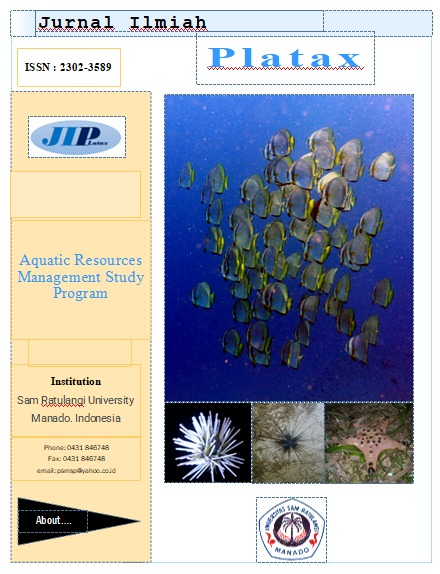The Abundance Of Sea Cucumber Species In The Waters Of The Wet Laboratory Of East Likupang, North Minahasa
DOI:
https://doi.org/10.35800/jip.v12i1.53189Keywords:
Sea cucumbers;, Holothuroidea;, Likupang;Abstract
Sea cucumbers, or Holothuroidea, are a class within the Echinodermata phylum. All organisms within this class possess characteristic spiny or knobbed skin composed of calcite particles. Several species of sea cucumber are internationally traded fishing commodities. The hunting of sea cucumbers is not only limited to the high-value species but also extends to lower-value species that initially garnered little attention. The sampling method used in this study began with a daytime location survey, followed by sample collection at night during the lowest tide, using a flashlight for illumination. All species of sea cucumbers found in the surveyed areas were collected. Following the collection, sorting was conducted where only two individuals of each morphological type, color, and other similar traits were kept, while the rest were returned to the waters. The sorted samples were then photographed for identification purposes, and to analyze the density of the discovered sea cucumber species, the number of individuals per suspected species was noted. The images of the collected samples were then compared with a guide for species identification. The World Register of Marine Species (WORMS) 2023 guide was used for this purpose. Subsequently, the number of individual species found was analyzed to determine the density of individuals and the abundance of sea cucumber species. The results of the identification process revealed 7 species with a total of 53 individuals.
Keywords: Teripang, Holothuroidea, Likupang
Abstrak
Teripang atau Holothuroidea merupakan salah satu dari kelas Echinodermata. Semuah golongan organisme ini memiliki ciri kulit yang berduri atau yang berbintil atau tersusun dari sat-sat kapur. Beberapa jenis teripang merupakan komoditi perikanan yang diperdaganngkan secara Internasional. Perburuan teripang tidak saja pada jenis-jenis yang berharga mahal, tetapi juga pada jenis-jenis yang berharga murah yang pada awalnya tidak memiliki perhatian.
Metode pengambilan sampel diawali dengan survei lokasi pada siang hari dan pengambilan sampel pada malam hari saat surut terendah dengan menggunakan senter sebagai alat penerang. Spesies yang diambil adalah semua jenis teripang yang ditemukan di perairan tesebut. Setelah teripang terkumpul dilanjutkan dengan penyortiran dimana hanya di ambil dua individu setiap bentuk morfologi, warna dan ciri lainnya yang sama. Sedangkan sisanya dikembalikan ke perairan. Sampel yang telah disortir, lalu difoto untuk keperluan iderntifikasi, kemudian untuk menganalisis kepadatan jenis teripang yang ditemukan dicatat jumlah individu setiap jenis yang điduga merupakan spesies/jenis yang sama. Sampel yang telah diambil foto/gambarnya dicocokkan dengan gambar panduan untuk identifikasi jenis. Panduan untuk mengidentifikasi digunakan WORMS (2023) Selanjutnya jumlah jenis individu yang ditemukan dianalisi untuk mendapatkan kepadatan individu dan kelimpahan spesies teripang. Hasil identifikasi ditemukan 7 spesies dengan jumlah 53 individu.
Katakunci: Teripang, Holothuroidea, Likupang.
References
Anonimous, 2012.Bioekologi teripang (Holothuruidea). Makalah seminar (http//yogimatoyaifransiskusyumagopeumspunip/2012/09/bioekologiteripang.
Darsono, P. 2003. Sumber daya Teripang dan Pengelolaanya. Bidang Bidang Sumber Daya Laut, pusat penelitian Oseanografi-LIPI, Jakarta. 1-9 hal.
Nontji.A. 1993. Laut Nusantara. Cetakan kedua.Djambatan. Jakarta. Hal 200-203. Pechenik, J,A. 1996.Biology of the invertebrates. 3rd ed. McGraw-Hill Companies, Boston: xvii + 555 pp.
Jasin, M. 1984. Sistematika Hewan (Invertebrata dan Vertebrata) untuk UniversitasCetakan Pertama. Sinar Wijaya.Surabaya. Hal 195-209.
Sutama. 1993. Petunjuk Praktis Budidaya Teripang. Penerbit Kanisius. Yogyakarta. 68 hal.
Downloads
Published
How to Cite
Issue
Section
License
Copyright (c) 2023 Christian Andre Horman, Gaspar D. Manu, Joudy R. R. Sangari

This work is licensed under a Creative Commons Attribution-NonCommercial 4.0 International License.
COPYRIGHT
Authors who publish with this journal agree to the following terms:
Authors hold their copyright and grant this journal the privilege of first publication, with the work simultaneously licensed under a Creative Commons Attribution License that permits others to impart the work with an acknowledgment of the work's origin and initial publication by this journal.
Authors can enter into separate or additional contractual arrangements for the non-exclusive distribution of the journal's published version of the work (for example, post it to an institutional repository or publish it in a book), with an acknowledgment of its underlying publication in this journal.
Authors are permitted and encouraged to post their work online (for example, in institutional repositories or on their website) as it can lead to productive exchanges, as well as earlier and greater citation of the published work (See The Effect of Open Access).




















